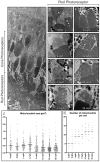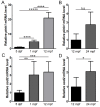Changes in Mitochondrial Size and Morphology in the RPE and Photoreceptors of the Developing and Ageing Zebrafish
- PMID: 36428971
- PMCID: PMC9688747
- DOI: 10.3390/cells11223542
Changes in Mitochondrial Size and Morphology in the RPE and Photoreceptors of the Developing and Ageing Zebrafish
Abstract
Mitochondria are essential adenosine triphosphate (ATP)-generating cellular organelles. In the retina, they are highly numerous in the photoreceptors and retinal pigment epithelium (RPE) due to their high energetic requirements. Fission and fusion of the mitochondria within these cells allow them to adapt to changing demands over the lifespan of the organism. Using transmission electron microscopy, we examined the mitochondrial ultrastructure of zebrafish photoreceptors and RPE from 5 days post fertilisation (dpf) through to late adulthood (3 years). Notably, mitochondria in the youngest animals were large and irregular shaped with a loose cristae architecture, but by 8 dpf they had reduced in size and expanded in number with more defined cristae. Investigation of temporal gene expression of several mitochondrial-related markers indicated fission as the dominant mechanism contributing to the changes observed over time. This is likely to be due to continued mitochondrial stress resulting from the oxidative environment of the retina and prolonged light exposure. We have characterised retinal mitochondrial ageing in a key vertebrate model organism, that provides a basis for future studies of retinal diseases that are linked to mitochondrial dysfunction.
Keywords: ageing; mitochondria; retina; zebrafish.
Conflict of interest statement
The authors declare no conflict of interest.
Figures







References
Publication types
MeSH terms
Grants and funding
LinkOut - more resources
Full Text Sources
Molecular Biology Databases

